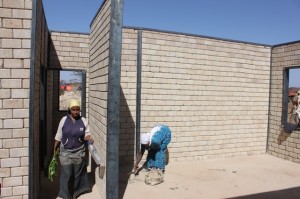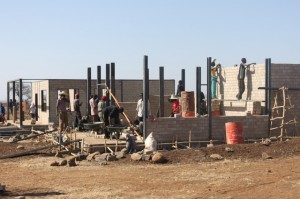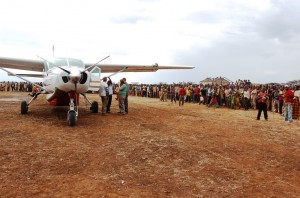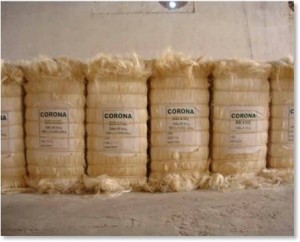Dry Farm Initiative
Government Farms
Government farms were hired to grow wheat. The crop seemed adequate, but the yield was a disaster because not much fertilization was done.
Evan’s Projects
Evan is currently (February 2010) working on several major projects. Six or seven containers of seed are ready to ship from the United States over to Ethiopia. Due to the high demand shipping season at present, no containers are currently available. He is also organizing and gathering together seed cleaning facilities and the equipment, such as augers, to run them.
Back to Top
Drought-Prone Areas in Ethiopia
In some areas of Ethiopia, there is not a lot of rainfall, even in the “wet” season. Last year when the local people in these areas planted several of their crop varieties, during the wet season, very little was actually harvested. Their crops simply could not tolerate the drought conditions. These drought-prone areas are part of the reason that MAI’s dry farming project was introduced in the country.
By planting dry farm crops in their normal wet season, that in reality doesn’t receive a lot of rain, locals will be given a crop that they can actually harvest. There is a lot of hope that this project, with the determination of those involved, will go a long way towards famine relief in Ethiopia.
In June of 2010, 500 acres of land will be planted in the drought-prone area of Langano. Two barely varieties from USU were previously introduced there, and they have grown quite well in those conditions.
Back to Top
Seed Farm
Houses and an office building also being constructed on the
Alyssa seed farm property for the main management and workers to live in.
On the runway there, a small plane was flown in, and it drew a lot of spectators; it was the first time many of those local people had ever seen one.
The Alyssa farm is currently managed by Allan Baum. Wes Haws, and his wife Alyssa, oversee the construction of the houses and the clearing of the land.
February 2010 Land Clearing Progress
The Alyssa seed farm in Beltu is in the process of being cleared. The area was overgrown with brush and it must be cleared and piled up. As of February 2010, only 1,000 of the 25,000 available acres have been cleared. The work is going much slower than anticipated, as things don’t always go according to plan there. By the end of this year 8,000 to 9,000 acres will probably be cleared. Hopefully, the second season crop will be planted in October of 2010.
Back to Top
Livestock Initiative
Lonny Ward is currently (March/April 2010) in Ethiopia on his fourth trip there. For this trip, he took over a shipment of jerky to see if the Ethiopians will like eating it and to see how that side of business will progress. The company needs to start generating revenue quickly, in order to start paying for itself.
Back to Top
Jerky
Paul has decided that he wants to create a jerky business in Ethiopia. Dr. Heven Hendricks and Lonny Ward have been working on the development of a jerky using Ethiopian spices to see if the local people will eat it. There really is no food product similar to jerky currently in Ethiopia.
Back to Top
Orchard and Tree Initiative
The MAI orchard initiative was developed to grow fruit tree varieties in Ethiopia. Part of this initiative was to grow these trees within a two year period of time, only irrigating during the first dry season. These trees are currently going through their second dry season (early 2010). The trees that survive come June or July will be promoted and planted throughout the region, as ones that would take little care as far as irrigation is concerned.
Back to Top
Shipments Bound for Ethiopia
Since his initial visit to Ethiopia, Lloyd Ward has tried to identify varieties of trees and plants that are not currently in Ethiopia, such as certain banana, mango, and pineapple varieties. His research concluded with a list of 162 new varieties, which he would like to see introduced and tested in various Ethiopian climates.
As of February 2010, three orders have been shipped to Ethiopia and a fourth order from Hawaii will soon be on its way. These shipments of plants, trees, and seeds are shipped to government research facilities in Ethiopia so that they can be planted there and tested for quality.
The Hawaiian shipment bound for Ethiopia contains trees, plants, fruits, and nuts – all beneficial for famine relief. It also includes bamboo. This variety of bamboo is tropical and different than what is typically grown in Ethiopia. Used for timber, the stocks of this bamboo are hollow and can grow to be 12 inches in diameter and 100 feet tall. It can be used for water pipes and construction, and it provides another economical benefit in that the shoots can be eaten.
The Ethiopian government will use these shipments of food plants, provided by MAI, to plant and run Adaptation Trials. These trials will check for any diseases that could develop in the plants, as well as make sure that they will not spread too much and become invasive. After the trials are completed, and if they are a success, the government will open MAI to spread the plants throughout Ethiopia.
Back to Top
Sisal Initiative in the Works
Villagers in Ethiopia are under the constant threat of drought conditions, and in many places they are starving. While Morrell Agro Industries is working to combat this, through dry farms and introducing alternative food sources, the process will require some patience; it is transforming a way of thinking and living. Simply handing these good Ethiopian people food and money was not the answer. Lloyd Ward wanted to find a way to assist them, without perpetuating the cycle of receiving help, without work, and then going hungry again, repeated over and over.
Lloyd sought to help Ethiopians help themselves by identifying local resources that can be bought and marketed in Ethiopia. In this system, a locally acquired resource could be bought from the villagers, so they can have money, or traded, so they can have food. A plant called sisal seemed to show promise as just such a resource that could be used to make a profit.
Sisal is used for fiber in various products, such as rope, twine, carpet, and floor mats. It grows in Ethiopia, and it could be harvested and collected by local people. There is a market for sisal in Addis, so it would follow that other local people could benefit from the harvesting of the plant, as well. This would be a great opportunity to create a more industrious people with hope for the future.





One Response to Current Developments (Early 2010)